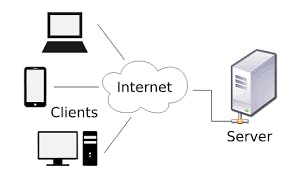This is my first blog, marking the beginning of my journey of learning in public and contributing to society and the open-source community. In this blog, I aim to share my knowledge about the fundamentals of computer networking.
What is Computer Network?
A computer network is a group of devices connected with each other through a transmission medium such as wires, cables etc. These devices can be computers, printers, scanners, Fax machines etc.
• The purpose of having computer network is to send and receive data stored in other devices over the network. These devices are often referred as nodes.
In the 1950s, There was competition between America and Russia. On Oct. 4, 1957, Russia Friday night announced the first successful launching of an earth satellite. To dominate Russia, America introduced The U.S. Advanced Research Projects Agency Network (ARPANET), the first public packet-switched computer network. It was first used in 1969 and finally decommissioned in 1989. this is the place where the story of the internet starts.
How internet connects the world?
Most of us (including me) are thinking internet connections are above the cloud with satellite but it's not true, actually internet connections are under the ocean by undersea cables. This is the cable that connects every one of us in the world
Take a look at the below picture of how undersea cable connects the world.

Today, there are around 380 underwater cables in operation around the world, spanning a length of over 1.2 million kilometers (745,645 miles).Underwater cables are the invisible force driving the modern internet, with many in recent years being funded by internet giants such as Facebook, Google, Microsoft and Amazon.
Below is a picture of an Undersea Cable.

Now you may wonder what is the internet? what are these protocols? what is www?
I'll explain all to you.
First what is the internet?
Definition of Internet
The Internet is a collection of different computers connecting with computers on a global scale or we can say it is a collection of computer networks.
Protocols: protocols are a set of rules for how data is transferred over the internet, meaning protocol enables computers to communicate with one another, basically how data is sent and received comes under protocol, it is developed by the Internet society.
WWW: world wide web developed by Tim Burners, allows access to all the documents and links present all over the internet.
PROTOCOLS
There are different types of protocols for how data is transferred over the internet,e.g.
TCP: transmission control protocol (the data will reach its destination and will not be lost or corrupted on the way)
UDP: user datagram protocol (when you don't care about 100% of data reaching the client) e.g. video conferencing.
HTTP: hypertext transfer protocol (used by web browsers) when a client sends a request to the server the server will send a response back all of these are given inside HTTP, how the server will send back the data.
Client and Server
Client is a computer that gets information from another computer called server in the context of client–server model of computer networks. The server is often (but not always) on another computer system, in which case the client accesses the service by way of a network. For example, web browsers are clients that connect to web servers and retrieve web pages for display. Email clients retrieve email from mail servers. Online chat uses a variety of clients, which vary on the chat protocol being used. Multiplayer video games or online video games may run as a client on each computer. The term "client" may also be applied to computers or devices that run the client software or users that use the client software.

Types of Computer Network.
There are mainly three types of computer networks based on their size:
1. Local Area Network (LAN)
2. Metropolitan Area Network (MAN)
3. Wide area network (WAN)
Local Area Network (LAN):
Local area network is a group of computers connected with each other in a small places such as school, hospital, apartment etc.
Metropolitan Area Network (MAN):
MAN network covers larger area by connections LANs to a larger network of computers. In Metropolitan area network various Local area networks are connected with each other through telephone lines. The size of the Metropolitan area network is larger than LANs and smaller than WANs(wide area networks), a MANs covers the larger area of a city or town.
Wide Area Network (WAN):
Wide area network provides long distance transmission of data. The size of the WAN is larger than LAN and MAN. A WAN can cover country, continent or even a whole world. Internet connection is an example of WAN. Other examples of WAN are mobile broadband connections such as 3G, 4G etc.

There are seven layers in a OSI model.
• Application layer
• Presentation Layer
• Session layer
• Transport layer
• Network Layer
• DataLink layer
• Physical layer
Application layer:
Application Layer provides the services to computer applications with the help of protocols that are defined in it
Presentation layer:
Presentation layer receives the data from top most layer which is application layer.
• The presentation layer converts the data(image, videos) into machine representable binary format Extended binary coded decimal interchange code translation.
• Before that it goes encoding, encrypted provides abstraction, compressed here SSL protocol is used.
• Then data is sent from presentation layer to session layer.
Session layer:
The main role of session layer is to setup and maintain the connection between different systems.
• It helps in setting up the and managing connections and it enables the sending and receiving of data followed by the termination of connective data
• Authentication and authorization
Transport layer:
The main role of transport layer is to check the reliability of data communication.
• Data transformed from session to transport layer.
•It is responsible for the transport of data eg: UDP & TCP.
Network Layer:
The main purpose of network layer is to receive the data segments from transport layer and transfer them from one computer to another computer on different network.
•Router lives over here
• Logical addressing (IP addressing)
•It assigns IP address sender and receiver to all the layer
• Load balance
Data link layer:
It allows to communicate directly to host and computers
•Physical addressing (MAC) is done in data link layer
•It's a 12 digit alpha numberic value
•Add mac address in frame and push to layers.
Physical Layer:
•We now learned that a transport layer converts the data into segments, network layer converts the segments into packets and data link layer converts the packets into frames.
•Physical layer converts these binary sequences into signals and transfer it through a transmission media such as cables etc.

In conclusion, computer networking is an essential aspect of modern computing, enabling users to access the internet, share files, and collaborate on projects. It has a rich history dating back to the 1960s when the US Department of Defense initiated the development of ARPANET. A computer network consists of several components, including network interface cards, switches, routers, and cables. There are several types of computer networks, including local area networks, wide area networks, and wireless networks. Network protocols, such as TCP/IP, UDP, and HTTP, govern the way data is transmitted between devices on a network.

